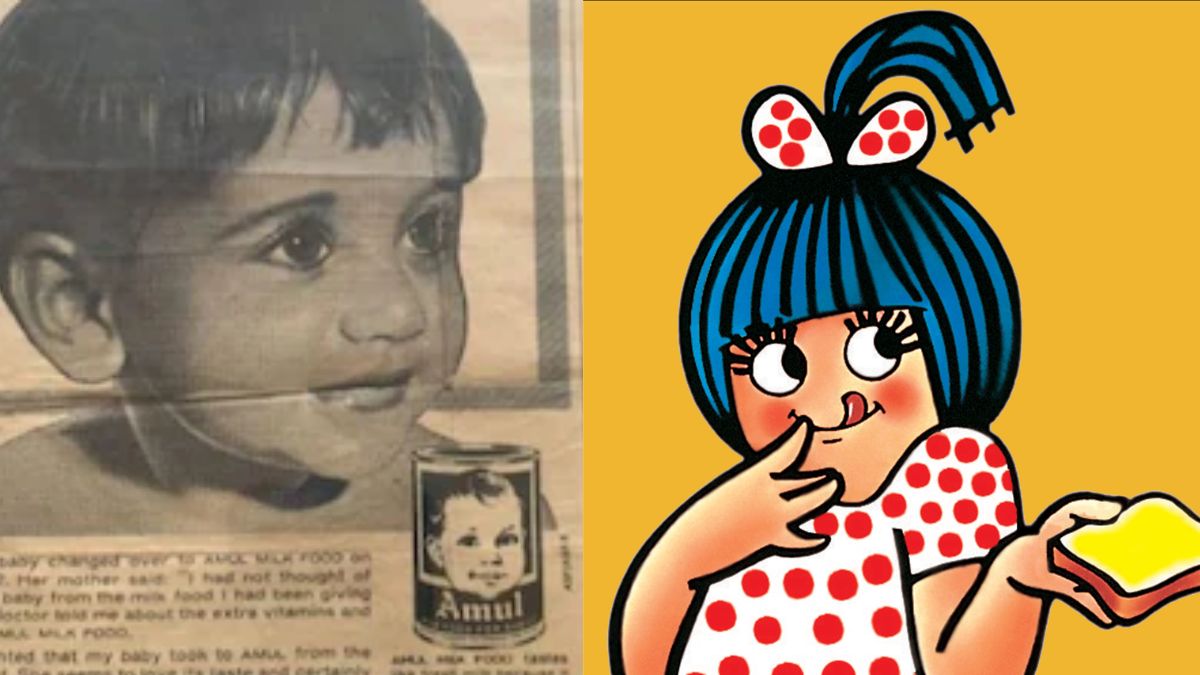For years, the blue-haired little girl in her red polka-dotted dress has been one of India’s most loved mascots.
The Amul Girl, with her cheeky one-liners and “utterly butterly” charm, has grown into a cultural icon, appearing on billboards and catchy print ads. Now, a new viral claim has brought her back into the spotlight — linking her origins to Congress MP Shashi Tharoor’s family.
The buzz began after Dr Sanjay Arora, a marketing consultant and speaker, posted a video on Instagram. In it, he shared who he believed was the “inspiration” for the Amul girl: it was the parliamentarian’s sister, Shobha Tharoor Srinivasan.
But how true is his claim? And what’s the real story behind India’s butter-loving little mascot? Let’s take a closer look.
What does the viral video claim?
The viral video begins with Dr Sanjay Arora posing a curious question: “What does this girl (Amul girl) and Shashi Tharoor have in common? That the face of India’s most famous butter girl – the cheeky blue-haired Amul mascot – was inspired by Shobha Tharoor, Shashi Tharoor’s young baby sister.”
The video not only traced the history of Amul’s marketing genius but also pointed to a photograph of Shobha as a baby, reportedly clicked by filmmaker Shyam Benegal, as the inspiration behind the mascot.
The video quickly took off online, garnering 1.8 million views, and soon reached the Tharoor family itself and the parliamentarian’s sister, Shobha Tharoor Srinivasan, responded on X (formerly Twitter).
Editor’s Picks
She acknowledged that she did feature in an Amul ad as a baby. Later, her sister Smita Tharoor also appeared as the second Amul Girl when the brand rolled out its first colour ads. However, Srinivasan clarified that she was unsure whether either of them had actually inspired the famous Amul mascot.
Interestingly, Shashi Tharoor himself had written years ago about his sisters’ appearances as “Amul babies.” The Tharoor family’s connection with the brand has even carried into his political career, when Amul once featured him in one of its topical cartoon ads when he entered politics.
Reacting to her response, Dr Arora doubled down, writing: “There you go, guys, Shobha Tharoor Srinivasan herself acknowledges and appreciates it.”
But as the buzz grew, Amul stepped in with an official clarification. The dairy giant put the speculation to rest, stating: “We wish to clarify that the Amul Girl illustration is not influenced by Ms Shobha Tharoor. She was created by Mr Sylvester daCunha and illustrator Mr Eustace Fernandes.”
The story behind the iconic Amul girl
In his video, Dr Arora also traced the backdrop of how the Amul Girl came into being. In the 1960s, Amul was still considered the underdog in the dairy market, while rival brand Polson dominated.
To stand out, Amul’s advertising head Sylvester daCunha decided to create a mascot that would break away from the image of Polson’s “sweet, soft butter girl.” By 1966, he began searching for a child model who could fit this vision. More than 700 photographs were reviewed, but none seemed right.
It was then that daCunha remembered his friend from Kerala, Chandran Tharoor. Reaching out to him, he asked for pictures of his children. According to the viral claim, when daCunha opened the envelope, he spotted a 10-month-old baby girl with a ponytail. That little girl, the video claimed, was Shobha Tharoor Srinivasan.
The photo reportedly struck a chord with him, and the wide-eyed, chubby baby became what he envisioned as the face of Amul.
Today, Shobha, now based in California, is an award-winning children’s author and voiceover artist. Speaking to The Hindu Businessline, she admitted she remembers little of the shoot but grew up surrounded by stories about it.
“We had large photographs that were hung around the house, and I had heard the stories about the Amul campaign. I was the first Amul baby, and the photos were in black and white. My younger sister, Smita, was the baby in the colour photos two years later,” she said.
So while the Tharoor sisters may indeed have been part of early Amul campaigns as “Amul babies,” the enduring blue-haired cartoon mascot, India’s butter-loving favourite, was the brainchild of daCunha and illustrator Eustace Fernandes.
DaCunha had also received guidance from Dr Verghese Kurien, widely regarded as the father of India’s White Revolution. Together, their vision gave birth to one of the most iconic mascots in Indian advertising history.
In June 2023, Sylvester daCunha passed away, leaving behind a legacy that continues to shape how Indians see and enjoy their “utterly butterly” Amul.
With inputs from agencies
End of Article

)

